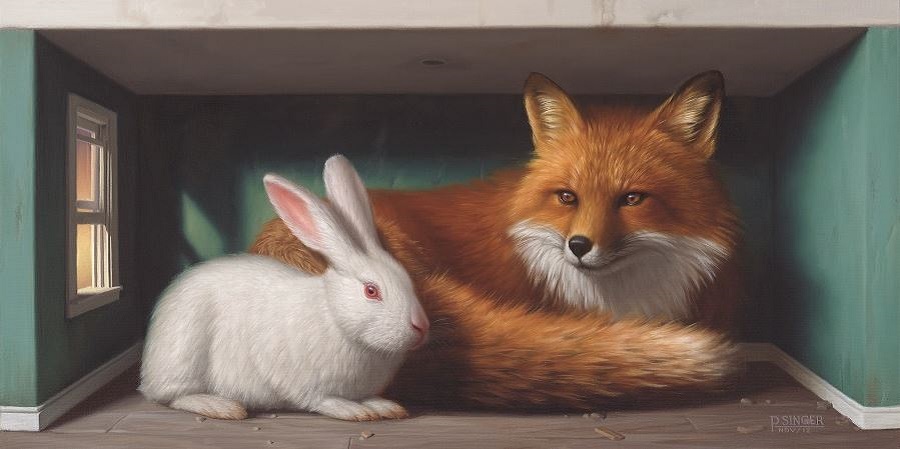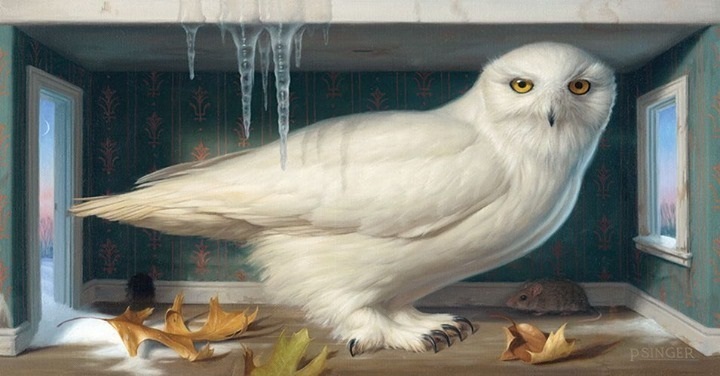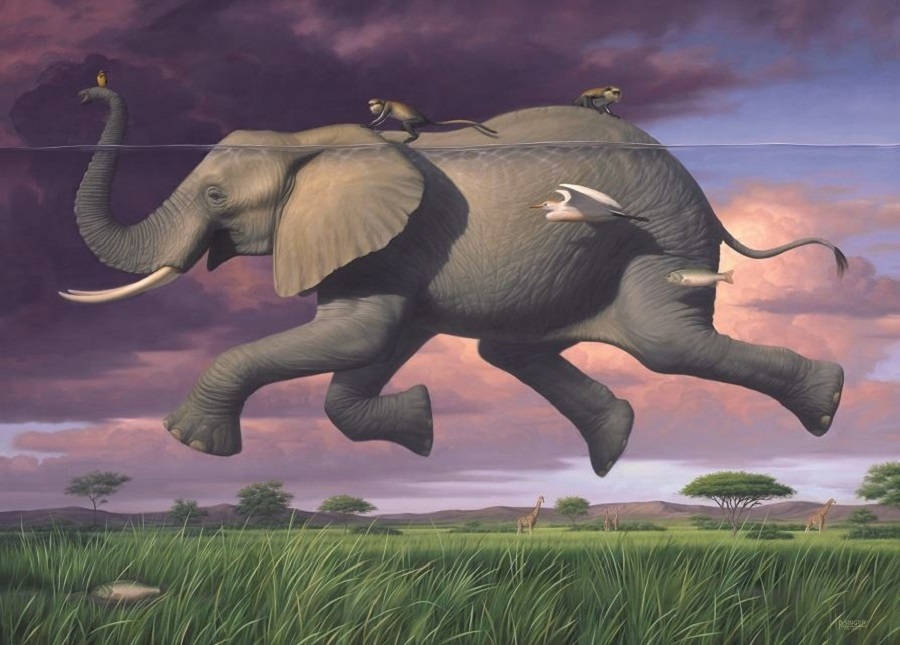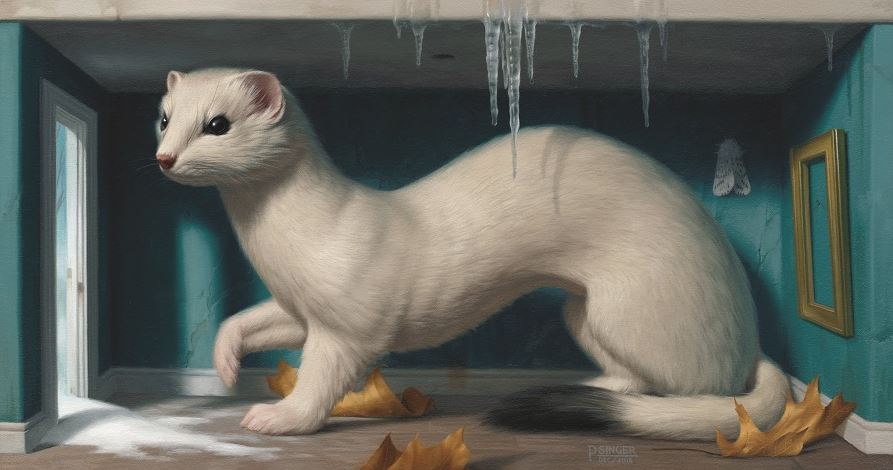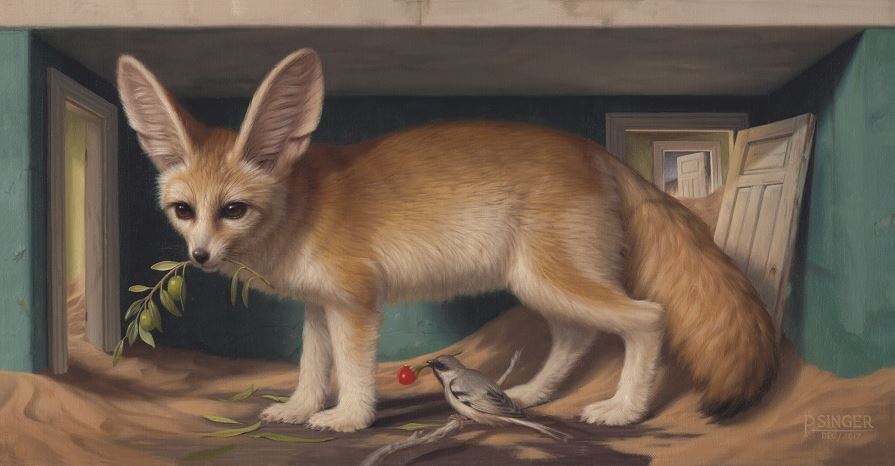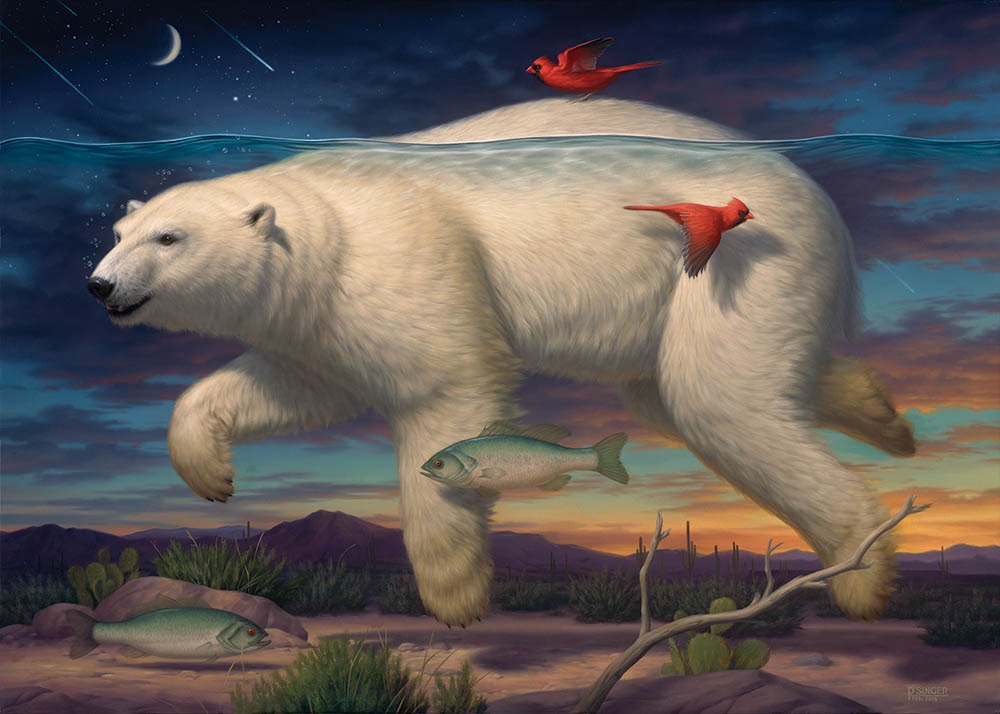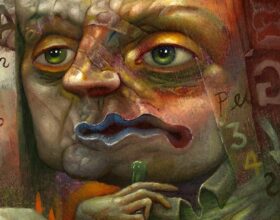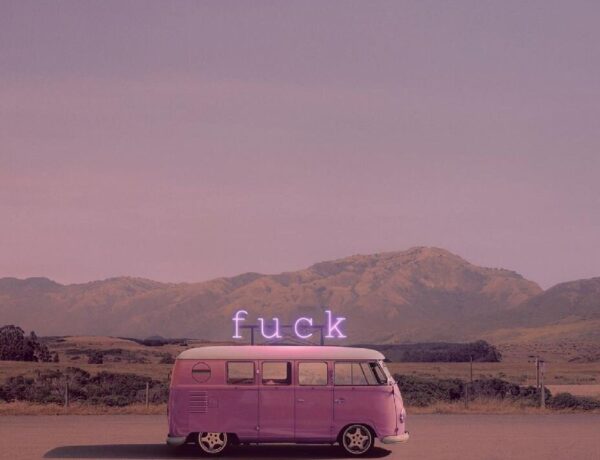Text below is from 2020 Beautiful Bizarre Art Prize Winner, Phillip Singer’s exclusive interview in the December 2020 Issue 31 of Beautiful Bizarre Magazine. The print issue is sold out, however you can still download the digital magazine here.
American artist Phillip Singer, featured in the December 2020 Issue 31 of Beautiful Bizarre Magazine, takes us on an untamed journey through worlds of feathers, fur, teeth, and claws. In these painted worlds, animals surprise in places we’d never expect to find them. Whales are floating down country lanes, dolphins in Nevada, sharks in bedrooms. It’s a quirky take on animal watching, with the wild closer than ever before. Phillip’s illustrative roots mean his subjects are painted in startling realism. There is a tangible majesty in the eyes, a grace in the movement of limbs and tentacles. But it is Phillip’s thirty-odd year career as a professional artist that has given his animals spirit and soul.
As an artist, Phillip can be described as inquisitive and quirky. His artworks often contain comedic oxymorons, puns, and irony. He jests with his subject matter, poking fun at the weird wonders of the natural world. This tongue-in-cheek creativity is what makes his paintings so charming. There is always nothing to be expected and everything to be discovered. Phillip’s approach to surrealism contributes to the mysterious messages he so naturally translates through paint. The worlds that Phillip creates are foreign yet familiar. He mixes just enough magic into the palette of everyday reality to somehow make the idea of flying elephants appear not so far-fetched after all.
Phillip achieves harmony in his paintings. He can take fish out of water and rehome them in the sky as if they belonged there all this time. Phillip skillfully suspends his animals on canvas, giving us a brief moment to study the beauty within them. This is why each artwork is so quietly peaceful. There is no discord. There is no hunt. There is only a sense of unity. It creates a very surreal balance, something our own world will always be lacking. In a way, Phillip paints the animal kingdom in a utopian light. But at the same time, his paintings remind us of the liberty we don’t always have, and the magic we don’t always see.
Mix animals with legends and make them villains or heroes and you’ve got something powerful.
Describe your early days as an artist.
I was an illustrator immediately after graduating from the School of Visual Arts in NYC. I was excited to get work right away. Most of it was book cover work. I remember thinking just before graduation that I would have to get a job as a waiter, but the phone rang and Avon books (HarperCollins) gave me three book covers in a children’s nonfiction series. That kept me going all summer and got the ball rolling. The challenges of being an illustrator were hard, but I learnt a lot about problem solving while meeting a deadline.
How do you think your approach to art has changed?
I’ve always been a realist painter and I just think in those terms. Early on, I was influenced by whoever was in close orbit; primarily other illustrators. My colours were very vibrant, everything was designed to pop. I suppose they still are, but my latest pieces have been a little more muted. I’m drawn to painters that are able to do so much with a more muted palette. Also, I feel I would always go for the joke in my artworks; it certainly reflects my dry sense of humour. Now, I would rather make more mysterious pieces.
What is the secret to maintaining a career as an artist?
If I figure that out, then I’ll be selling the answer in book format. I’m not very good at ‘blowing my own horn’. I’ve always felt the work should speak for itself. That is a bit naïve though. I see very mediocre artists have high flying careers, while unbelievable artists struggle for attention. I’m also pragmatic. I can separate a business decision from an artistic one. I’m not saying anyone should compromise their integrity as an artist. There are jobs I did as an illustrator that were strictly for the money. I had no real interest in the image. Others, I did because I had artistic control over what I created and was given the format to display my vision.
For all the childhood readers, what was it like working as an illustrator for National Geographic?
I only did two illustrations for National Geographic. One job required me to paint different foods and different architecture. The other job required me to do a painting of relief sculptures that revealed how the army of Alexander the Great would fight. The funny thing is that I had to paint the sculptures twice. It was pointed out by a history professor that no one could hold spears in the way I had depicted them, so the job had to be redone. But that is the job of an illustrator.
Do you believe you would still be the same artist today without your background in illustration?
No. When I was going to school I was searching for instruction. I wanted to be taught why my drawings weren’t very good, why my colour was muddy. I was constantly pushed away from these questions in the fine arts department. I was told, “That’s not really art.” I found teachers in the illustration department shared my point of view.
Your medium of choice is oil. Why does oil painting appeal to you so much?
It wasn’t always oil. I used to paint in a similar style with acrylics. My introduction to oils in school was a joke. I was given a list of what to buy and told, “Do whatever you want.” That’s the point at which I could have used an Atelier type of lesson. So, I ran away from oils because I wasn’t getting any help with how to use them. Acrylics were easier for me to figure out. Today, I can’t imagine working without oils. I can make my paint dry quickly. I can keep it wet for a week at a time. There are so many ways to apply the paint. I constantly look at other artists’ work and think “how did they do that?”
Where do you find your muse?
I’ve always found this the most difficult question to answer, but I understand why people ask it. I just like to make things. I really don’t know how to relax. I guess I’m kind of good at making paintings. That is the unvarnished truth about how I started creating art. I had to be pushed into it. Of course, I’ve grown to love it after stumbling into it. Now it consumes me. Inspiration is everywhere. There’s so much imagery we’re bombarded with every day. I feel challenged to make something beautiful, unique, thought-provoking or powerful. I enjoy that challenge. Painting is probably the closest I’ll ever get to meditating. I could say that painting keeps the dogs from barking in my head.
Describe the process of painting the outsider.
Reference reference reference. I just can’t get my hands on enough of it. I dream these ideas up then find ways to bring them to life. I never just find a photo of a creature and say, “I’m going to paint this.” I draw, redraw it and redraw it until I’m happy. I enlarge the drawing onto tracing paper and transfer it onto a grey canvas. Then I do a small colour study. From there, the toughest part is bringing it to life when there really isn’t a piece of reference that looks like my painting. I might work on something for hours only to come back to it later and say, “Hmmm, that’s not working.” When I take so long to complete a piece, I get plenty of additional ideas that come to mind so the concept can get altered along the way.
Can you explain the title the outsider?
Titles can come to me after the first sketch or sometimes weeks after a painting is finished. In the end the title can provide a narrative for the piece. I was thinking of how the term ‘outsider’ is used to denigrate people who are new to any area. I don’t like that. I hoped to steal the term back and celebrate the outsider and welcome them. I can’t imagine how difficult it can be for people to leave one environment and try to make a life in a new environment.
Explain the themes explored in your in my room series.
Isolation, comfort, partnerships, ownership, shelter, fear. Playing with the scale and placement creates these notions. Leaving a doorway empty in Nothing Ventured shows how we can be paralysed by the unknown; trapped by comfort and familiarity. Placing almost any animal in an abandoned room begs the viewer to consider what came before. Put multiple animals in a room and the possibilities multiply.
Do you label yourself as a magical realist?
I’ve used that hashtag plenty of times, but I suppose it’s a description that others have put on me. I’m not positive I have a full understanding of what it really means.
There seems to be many references to balance and suspension in your works. Is this a commentary?
At first, it was not meant as commentary. Most of the subjects I’ve painted start with the subjects themselves: animals, rocks, flowers. Of course, all of these have been painted a million times before so I ask, “What should I do with these things?” From there, I mentally toss things in the air and see where they land. Most of the time, I look at where they land and I think mmm, there’s nothing here, this bores me. But I keep playing with it and hopefully I see something. Small things pulling and carrying big things is always a theme that tends to inspire.
What are the artistic choices behind your country landscapes?
I really like to make the animals pop off the page. Having a big sky behind them lets me do whatever I need to do to make that happen. I can move remove clouds, paint bright daylight or dark night behind them. Sea creatures are just so fluid, languid and dreamy so I immediately picture them in a night-time sky. As if the dreams of people in the houses in the background are actually taking place outside. When I was a young teenager, the youngest of four, I would draw in my room and listen to records, but the only records I had belonged to my brothers and sister. There was one album by Pat Metheny and Lyle Mays. I would play it over and over. It had a very plain photo of some flat Great Plains landscape on the album cover. It really wasn’t an exciting cover but for some reason the music helped burn this image into my head. It also created this dream-like quality about that landscape in my head. I’m no expert on that part of the country, but it’s kind of fun to keep the perception of mystery alive. I think that comes out in paintings like The Outsider. It’s strange what sticks to the mind and what drifts away.
Why do you think animals are such timeless subjects in art?
It lets people think about relationships in an abstract way. It’s easier for people to view an issue between a rabbit and a fox than it is to view an issue between two people. Fables are often told through animals. Team mascots are animals. Ancient gods took the form of animals. I suppose it’s easier to hear a life lesson from a wise old owl than it is to hear from the old man down the street. Animals are living breathing objects of art. Mix animals with legends and make them villains or heroes and you’ve got something pretty powerful, I suppose. Add stripes, spots, fangs, claws, strange eyes, hooves, fins etc – you’ve got a real show happening. Next you realise these creatures really do exist somewhere in the world and you’ve got a very compelling subject matter.
I suppose it’s easier to hear a life lesson from a wise old owl than it is to hear from the old man down the street.
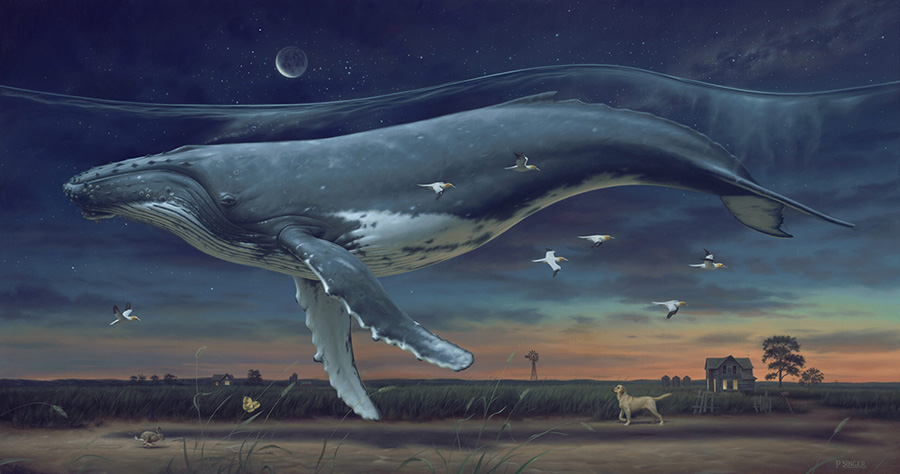
If you had to choose a spirit animal, what would it be and why?
An indecisive sloth. I paint so damn slow. It’s tough enough moving so slow but imagine repeatedly asking yourself: am I moving in the right direction?
Where does the magic happen? Describe your studio.
It’s a simple set up. A spare room of the house. I don’t have the natural light I want but I still have all the light I need. Props, books and models line one of the walls but I like to keep my view of the easel uncluttered. I get a little sound from the stream in the backyard whenever I turn off all other distractions. I should describe the studio I wish I had. My old studio. A detached two car garage I spent two years renovating. It was perfect. However, my wife and I wanted to start a family and the home was too small. We moved and adopted twin girls. I never did convert the new garage to a studio but I’m happy as it is right now.
How did it feel to win the Beautiful Bizarre Art Prize 2020?
Unfuckingbelievable. Is that one word? There is so much imagery out there. I’ve shown my work for so many years at art festivals and was confident that I had an audience large enough to support me. But I’d figured I was new to the jury. I feel like I’ve been moving underground for decades. I didn’t have many followers on social media and I just didn’t know if it was going to connect. So, I am really surprised the judges thought enough about my work to give me this award.
Before winning the 2020 Beautiful Bizarre Art Prize, I had no galleries that could actually sell my work, and very few followers on social media. The Beautiful Bizarre Art Prize was the endorsement my career needed! Now everything has changed – and the prize money was a huge help, particularly last year!
Phillip Singer Social Media Accounts
Website | Facebook | Instagram


